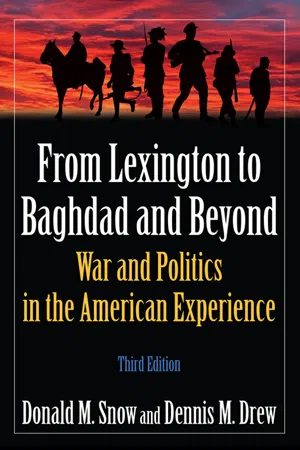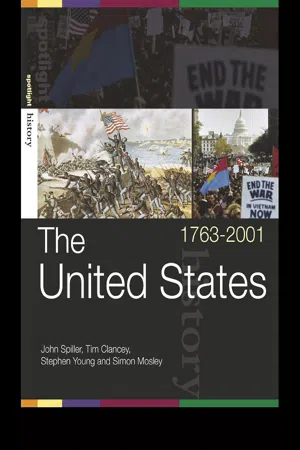History
The American Civil War
The American Civil War was a major conflict fought from 1861 to 1865 between the Northern states (Union) and the Southern states (Confederacy) over issues including slavery, states' rights, and the preservation of the Union. The war resulted in significant loss of life and ultimately led to the abolition of slavery in the United States with the Union emerging victorious.
Written by Perlego with AI-assistance
Related key terms
4 Key excerpts on "The American Civil War"
- eBook - ePub
Understanding Civil Wars
Continuity and change in intrastate conflict
- Edward Newman(Author)
- 2014(Publication Date)
- Routledge(Publisher)
The American Civil War 1861–65The American Civil War of 1861–65 has been described as the first ‘industrial’ war.1 Its scale, human impact and the implications that it had for international politics mark it as one of the defining civil wars. The conflict is generally portrayed as a clash of interests and values between northern and southern states, underscored by divergent economic, racial and cultural systems.2 However, there is no single, objective account of the meaning and nature of The American Civil War. There are conflicting narratives about the most fundamental questions of the conflict, including its causes and consequences, issues of conduct and justice, and its legacy. Debates about the civil war are often, in the United States at least, characterized by differing ideological perspectives and perennial controversies, such as the balance between local and federal authority, and the nature of southern and northern identity, amongst other things.3 Even its name can be a source of controversy. Whilst the ‘American Civil War’ is now the prevailing description, at the time of the conflict the terms ‘War of the Rebellion’ or ‘War for Southern Independence’ were commonplace, and interpretations of the conflict are still often contested.4 In the south the conflict was for many participants and observers a second war of independence, or a second revolution; from a northern perspective it was a struggle to maintain the integrity of the American project and everything for which the founding fathers had fought. Above all, the debate about the causes of the conflict has been beset by differences in interpretation and historical revisionism.5 - eBook - ePub
From Lexington to Baghdad and Beyond
War and Politics in the American Experience
- Donald M Snow, Dennis M. Drew(Authors)
- 2015(Publication Date)
- Routledge(Publisher)
3CIVIL WARThe American Civil War represents the greatest American national trauma. It was the first conflict in the American experience that clearly and unambiguously met the dual criteria of total war. The issue of union or disunion of the country was all-encompassing and could be resolved only on the field of battle, and the war became a match between totally mobilized societies. The result was the bloodiest war in American history. When the last gunpowder haze rose and Robert E. Lee and Joseph E. Johnston surrendered the remnants of their armies, more than 600,000 had died and nearly another 500,000 had been wounded. And it had all been done at our own hand.In many ways the Civil War was warfare in transition, a junction between the classical conflicts of the eighteenth century and the massive carnage of the twentieth century. Tactically, battles were organized and fought along the lines of the Napoleonic campaigns by armies led by officers who had learned to fight that way at West Point, and both sides (especially Lee’s) were obsessed with the “decisive battle” concept integral to Napoleon’s success.At the time no one really appreciated how the face of war was changing. Partly this was the case because it was a war fought and led by men who were largely inexperienced in combat when it began. The soldiers available were largely untrained militia (in the American tradition) who could neither drill nor, in many cases, fire a gun. The war’s first major battle, First Manassas (Bull Run), showed both sides how poorly prepared they were for the war and how difficult the task would be. After First Manassas both sides mobilized their societies, and in the following spring when the real fighting began, war machines of unprecedented size were ready to grind against one another and produce equally unprecedented carnage. - eBook - ePub
Rethinking the Civil War Era
Directions for Research
- Paul D. Escott(Author)
- 2018(Publication Date)
- The University Press of Kentucky(Publisher)
1Understanding the Roots of WarA fundamental part of Civil War studies has always been analysis of the causes of the war. Except for books about Lincoln and military history, which have included the work of many nonacademic historians, probably no other topic has attracted as much attention. And perhaps in no other area have change and progress been so great. The overall way that we try to understand the roots of the war is very different now from the way it was understood in the 1960s or 1970s.When I began graduate school, many important studies focused their attention on the events of the sectional conflict, the friction points that eventually led to civil war. Through careful research, historians tried to understand the sequence of North–South conflicts, how each collision affected the Union, and how these successive clashes aggravated the tensions that brought about secession. Some interpretations had a pro-Southern slant, whereas others showed more appreciation for abolitionists or Northern antislavery sentiment. If many scholars were moving away from James G. Randall’s earlier argument that a “blundering generation” of politicians caused a needless war, the focus of their attention had not changed. Their priority remained to elucidate the debates and crises that produced growing tension.The efforts of this period produced some outstanding research and trenchant analysis. If Roy Nichols previously had identified the way battles over the right to petition broadened into fear of a Slave Power, others such as Joel Silbey and Michael Holt offered important new insights about party realignment. To understand the actions of political leaders, we continue today to turn to studies of the Compromise of 1850 as well as of Henry Clay or Stephen Douglas or John C. Calhoun or others, and valuable studies of such prominent leaders continue to appear. One of the most enduring of all the political histories is David M. Potter’s book The Impending Crisis, 1848–1861.1 - eBook - ePub
- Tim Clancey, Simon Mosley, John Spiller, Stephen Young(Authors)
- 2004(Publication Date)
- Routledge(Publisher)
Problems in American Civilisation, D.C. Heath (1993).Eric Foner, Free Soil, Free Labor, Free Men, Oxford University Press (1970). Quoted in Kenneth Stampp (ed.), The Causes of the Civil War, Touchstone (1991).Susan-Mary Grant, ‘For God and Country . . .’, History Today, issue 50 (7), July (2000).Michael Johnson (ed.), Abraham Lincoln, Slavery, and the Civil War – Selected Writings and Speeches, Bedford (2001).Brian Holden Reid, The Origins of The American Civil War, Longman (1996).Michael Holt, The Political Crisis of the 1850s, Norton (1978).Maldwyn Jones, The Limits of Liberty, Oxford University Press (1983/1995).James McPherson, Battle Cry of Freedom, Penguin (1990).James McPherson, For Cause and Comrades, Oxford University Press (1997).John M. Murrin, Paul E. Johnson, James M. McPherson et al., Liberty Equality Power, Harcourt (2001).Derrick Murphy, Kathryn Cooper and Mark Waldron, United States 1776–1992, Collins (2001).Russel B. Nye, Fettered Freedom, Michigan State University Press (1949). Quoted in Kenneth Stampp (ed.), The Causes of the Civil War, Touchstone, Simon & Schuster (1991), p. 20.Kenneth Stampp (ed.), The Causes of the Civil War, Touchstone, Simon & Schuster (1991).Hugh Tulloch, The Debate on The American Civil War Era, Manchester University Press (1999).Howard Zinn, A People’s History of the United States
Learn about this page
Index pages curate the most relevant extracts from our library of academic textbooks. They’ve been created using an in-house natural language model (NLM), each adding context and meaning to key research topics.



